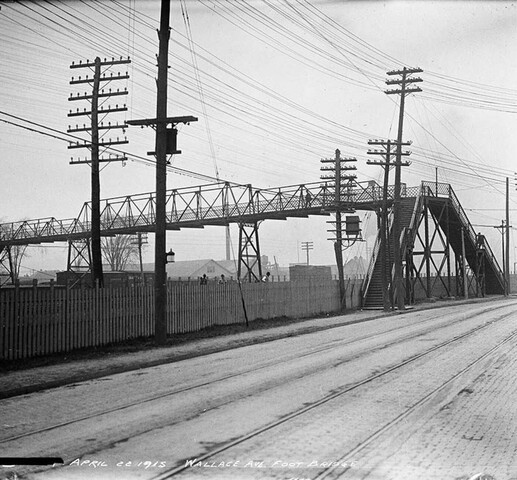
Wallace Avenue Pedestrian Bridge
The Wallace Avenue Pedestrian Bridge
Wallace Avenue – Dundas Street West Footbridge, built 1907, Wallace Avenue and Sousa Mendes Street, Toronto, April 22, 1915. Image: City of Toronto Archives
Wallace Avenue Pedestrian Bridge, built 1907, corner of Wallace Avenue and Sousa Mendes Street, Toronto, March 20th, 2021
View from the Wallace Avenue Pedestrian Bridge, built 1907, Wallace Avenue and Sousa Mendes Street, Toronto, March 20, 2021
A temporary fix
The Wallace Avenue Pedestrian Bridge has been a Junction Triangle landmark since 1907, when residents of the area needed an easier way to get across the above-ground rail tracks that ran along Dundas Street West. The rail tracks, which served the Canadian Pacific Railway, were laid in the late 1800s. At the time, the area surrounding the tracks was predominantly rural, with few homes or factories. The growth of the Junction Triangle neighbourhood in the early 1900s meant residents and railways increasingly bumped up against each other. To cross the tracks, area residents had to trek north to Dupont Street or south to Bloor Street to reach anything on the other side: schools, shops, or work. The community called out for a fix to the situation and the Ontario Bridge Company entered the scene with what was to be a temporary solution to the problem: the Wallace Avenue Pedestrian Bridge.
A permanent solution
The Wallace Avenue Pedestrian Bridge is a multi-span, steel, Warren pony Truss footbridge – and is one of a few bridges of its kind found in Toronto. The Wallace Avenue bridge is supported by a series of equilateral metal triangles placed on either side of the bridge, known as “Warren pony trusses.”
In 1907, this style of bridge was very popular as it was relatively cheap to build: the cost to build the Wallace Avenue bridge was a modest $4,500. The style of bridge was also perfect for what was meant to be a temporary fix for pedestrians needing to cross the railway. Once the Wallace Avenue Pedestrian Bridge was built however, people liked it and the bridge became a permanent feature of the Junction Triangle neighbourhood. Over a century later, the same bridge is still standing. Heritage Toronto erected a plaque to commemorate the building of the Wallace Avenue Footbridge in 2014 at 391 Wallace Avenue.
Industrial heyday
From the Wallace Avenue bridge, one can see the remnants of the Junction Triangle’s past industry and infrastructure, including buildings such as the Toronto Hydro Junction Substation (1911), and the Viceroy Manufacturing building (1929), along with many industrial warehouses that would have once been bustling with activity.
In the early twentieth century, many factories opened in the area, providing jobs to the growing population of immigrant workers. This included Watt Milling and Feed Co., Canadian National Carbon Co. (a dry battery manufacturer), the Toronto Wire Nail & Tack Co., and several food production plants. Cowan Company Ltd. was a popular chocolate producer, and Tolfer Bros. were known for their biscuits — both companies opened production facilities in the Junction Triangle area. By the 1930s, one could find all kinds of products being made in the neighbourhood. This period marked the Junction Triangle’s industrial heyday.

